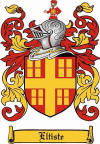
Eltiste-Kaiser Web Site
Bavaria ~Coat of Arms

Bavaria, which was a part of the Roman Empire until the 5th century, was named after the ancient tribe of the "Bajuvaren", who settled in the region after the period of Roman occupation. In the 6th century, the German territories were inhabited by Saxons in north central Germany, East Franks along the lower Rhine, Thuringians between them, Bavarians along the middle Danube, and Swabians between the upper Rhine and Upper Danube and along the Northern Alps. In the 9th century, the Frankish Emperor Charlemagne incorporated Bavaria into his Empire despite the heroic attempts at resistance made by the Bavarian Duke Tassilo.
Charlemagne's conquest brought temporary unity to the tribes, but the collapse of the Carolingian Empire loosened these bonds of common order. Tribal consciousness and local particularism fought all centralizing influences until the age of Otto von Bismarck. The provincial dukes, who were enfiefed to the King of Germany, each provided for their own defense. They organized their armies by giving lands in fief to retainers who paid in military service. The armies gave the dukes virtual independence of the crown and established the feudal system in Germany. However, in the 10th century, Otto I became King of Germany and persuaded the Dukes of Lorraine, Franconia, Swabia and Bavaria to act as his attendants in the coronation ceremony at Aachen. The King subordinated the dukes, made the German Church a national institution, and fused the German tribes into a powerful state. The province of Bavaria came under the control of the ducal houses of Saxony, Franconia, and finally the Welfen family dynasty. In the 12th century, the Welfen family enjoyed the peak of their power under Henry the Lion, the Duke of Bavaria and Saxony. From the 12th to 20th centuries, Bavaria was ruled by the powerful Wittelsbach dynasty. In the 19th century, the course of Bavarian history was drastically altered.
After the Congress of Vienna in 1815, the various German states began to move toward the creation of a modern and united German nation. After the Revolutions of 1848, and the rise of Bismarck, Germany expanded territorially, developed its economy, and emerged as a great world power. German Unification was proclaimed in 1871, by which time Germany had attained roughly the size and boundaries it would have in the 20th century. In the quaint and picturesque cities of Bavaria, the tradition of German craftsmanship was formed. Craftsmen from Augsburg, an ancient city that was founded by the Romans, produced the first muskets and mobile artillery. The weavers and textile manufacturers of Augsburg also became well known. Nuremberg, where the German Emperor once resided, was the site of the first German railway in 1835 and was the cultural and economic center of the German Empire. The artisans of Nuremberg invented the pocket watch. Wagner's opera, "Die Meistersinger", portrays the famous singing contests that took place in this historic city. Munich, the capital of modern Bavaria, is a historic and beautiful city that is home to numerous museums, galleries and the castle of Nymphenburg.
Modern Bavaria is also known for its world-famous Oktoberfest festival and is popular with tourists from around the world.

|
|
 |
|

Family Indexes
Home Kaiser Eltiste Fink Rohrs
Eltiste Photos Kaiser Photos Rohr Photos Fink Photos
Last Up-Date 12/24/2006 10:56:42 PM